Even though all of the telescopes listed in this roundup are plenty good for planetary visual observation too, this is mostly geared toward planetary imagers. For visual use, the only things really important about choosing a telescope for planetary viewing are that it has good optics, a sturdy and easy-to-move mount, and as large an aperture as possible (AKA most Dobsonians).
While GoTo is obviously not really needed to find the planets, with GoTo comes tracking, and with tracking comes a lot of convenience. It’s pretty much required for planetary imaging, as nudging the telescope along manually tends to cause vibrations, ruining your capture, and can put the target outside the field of view of your camera. Thus, many of the planetary imaging telescopes recommended here are GoTos.
Best Planetary Telescopes Overview
- Under $250: SarBlue Mak60 Dobsonian Mounted
- Between $250-$500: Sky-Watcher Virtuoso 90
- Between $500-$600: Celestron Astro Fi 102 Mak GoTo
- Between $600-$800: Celestron NexStar 127 SLT Mak GoTo
- Between $800-$1000: Celestron Nexstar 5SE Schmidt Cassegrain GoTo
- Between $1000-$1200: Celestron Nexstar 6SE Schmidt Cassegrain GoTo
- Between $1400-$1800: Celestron Nexstar 8SE Schmidt Cassegrain GoTo
- Between $1800-$2200: Celestron 8″ NexStar Evolution Schmidt Cassegrain GoTo
- Between $2200-$3000: Celestron Advanced VX 9.25″ Schmidt-Cassegrain GoTo
- Between $3000-$3500: Celestron Advanced VX 11″ Schmidt-Cassegrain GoTo
Best Planetary Telescopes – Individually Reviewed
1. SarBlue Mak60 Dobsonian Mounted – Under $250
- Great optics
- Extremely compact
- All-manual
The SarBlue Mak60 is, of course, way too small to do much imaging with, though it does come with an eyepiece-to-smartphone adapter for moon shots if you wish to take those. You get a tiny, 60mm (2.4”) aperture Maksutov-Cassegrain with a focal length of 800mm, a usable 5×24 finderscope, an Amici prism erecting star diagonal, a 20mm (40x) Konig eyepiece, and a stable, simple Dobsonian mount. The Mak60 is completely useless for viewing objects besides the Moon, planets, and double stars, but it does very well on these bright targets. The telescope is also lightweight and compact enough to fit in a small backpack; the optical tube is barely bigger than a soda can.
2. Sky-Watcher Virtuoso 90 – Choice Between $250-$500
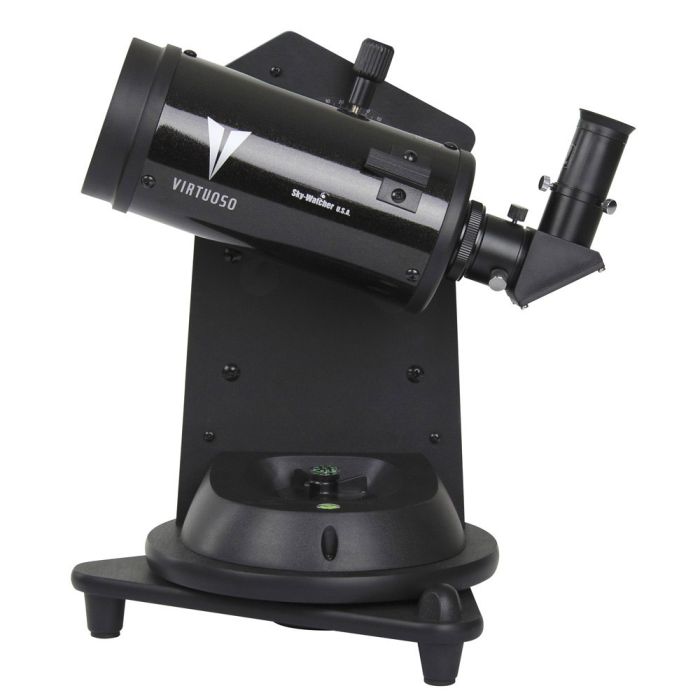
- Lightweight, compact design
- Motorized tracking
- Solar filter included
The Sky-Watcher Virtuoso 90 packs a lot into a tiny package—with great optics, motorized tracking that sets up in seconds, a pair of quality eyepieces, and even a safe solar filter. You can do a lot with this scope. The motorized tracking means that planetary imaging with a proper camera is possible, and all you need to do to start it up is point the scope north and turn the mount on.
The Virtuoso’s 90mm (3.5”) f/14 Maksutov-Cassegrain optics are great at showing lunar and planetary details—as well as sunspots, which can be seen if you attach the included safe solar filter. The Virtuoso 90 includes a 5×24 finderscope, a 1.25” prism star diagonal, and two Super 1.25” eyepieces—a 25mm (32x) and a 10mm (125x), which are all you’re likely to ever need with this telescope.
3. Celestron Astro Fi 102 Mak GoTo – Choice Between $500-$600
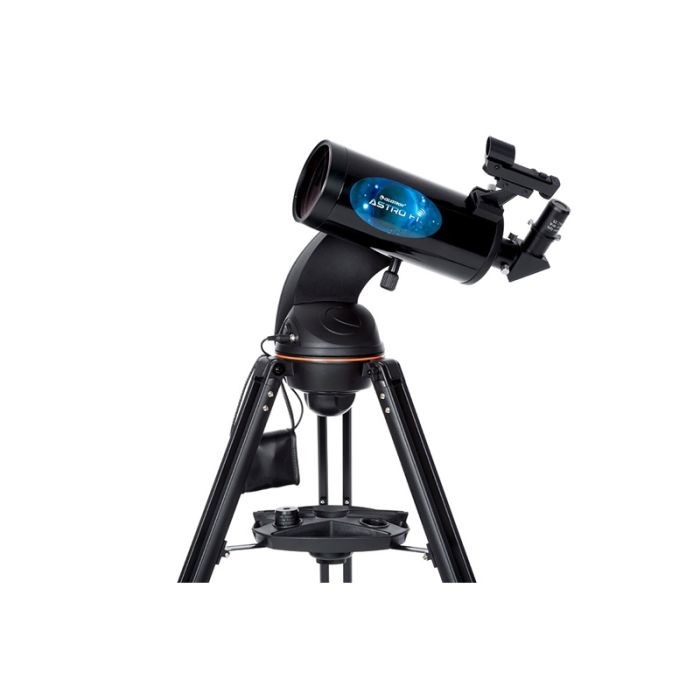
- Lightweight and compact
- Full GoTo controlled via your phone/tablet
- Great optics
The Celestron Astro Fi 102 is the smallest of the telescopes on our list that comes with a tripod and full GoTo capability. The Astro Fi mount is a computerized GoTo mount that automatically swings across the sky and tracks whatever you point it at after a simple setup and alignment process, and the whole thing is controlled via your smartphone or tablet with the SkySafari app or Celestron’s free SkyPortal WiFi app. The Astro Fi 102 is a 102mm (4”) f/13 Maksutov-Cassegrain and provides sharp images with almost any eyepiece, such as the included 25mm (53x) and 10mm (133x) eyepieces, which might be the only eyepieces you need to use with this telescope. As with any other Maksutov-Cassegrain, no collimation adjustments are required.
The Astro Fi 102’s mount head and the optical tube will easily fit in a backpack or suitcase, and the tripod can be dismantled (with tools) to fit in a suitcase if you’d like to fly with it too. The motorized mount will allow you to do some planetary imaging with a high-speed CMOS camera and a 2x Barlow lens, too.
4. Celestron NexStar 127 SLT Mak GoTo – Choice Between $600-$800
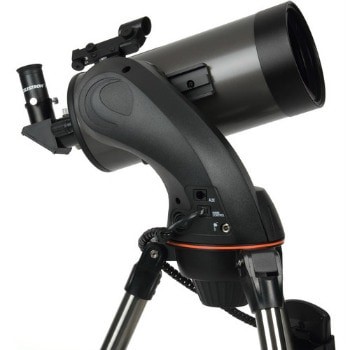
- Lightweight and compact
- GoTo capabilities
- Great optics
The Celestron NexStar 127 SLT is essentially a scaled-up Astro Fi 102 Maksutov, though with an older-generation mount that requires a hand controller for use rather than being run off your smart device (though an aftermarket adapter can be purchased to allow such with the SLT mount). While internally stopped down to only 120mm (4.7”), the NexStar 127 SLT still provides significantly sharper and brighter images than Celestron’s smaller 102mm Mak. You get a 1.25” prism star diagonal, red dot finder, and two 1.25” eyepieces – 25mm (60x) and 10mm (150x) Kellners too.
As with the Astro Fi 102, the Celestron NexStar 127 SLT is quick to set up, taking only a few minutes to be aligned in the sky, and you can do planetary imaging using a suitable CMOS camera and 2x Barlow lens. The NexStar 127 SLT is a little hard to fit in a backpack – at least with the tube still attached to the mount head – but the whole scope is still small enough to bring on a plane and fit in the trunk of the smallest vehicles, and carrying it even long distances fully assembled isn’t much of a hassle.
5. Celestron Nexstar 5SE Schmidt-Cassegrain GoTo – Choice Between $800-$1000
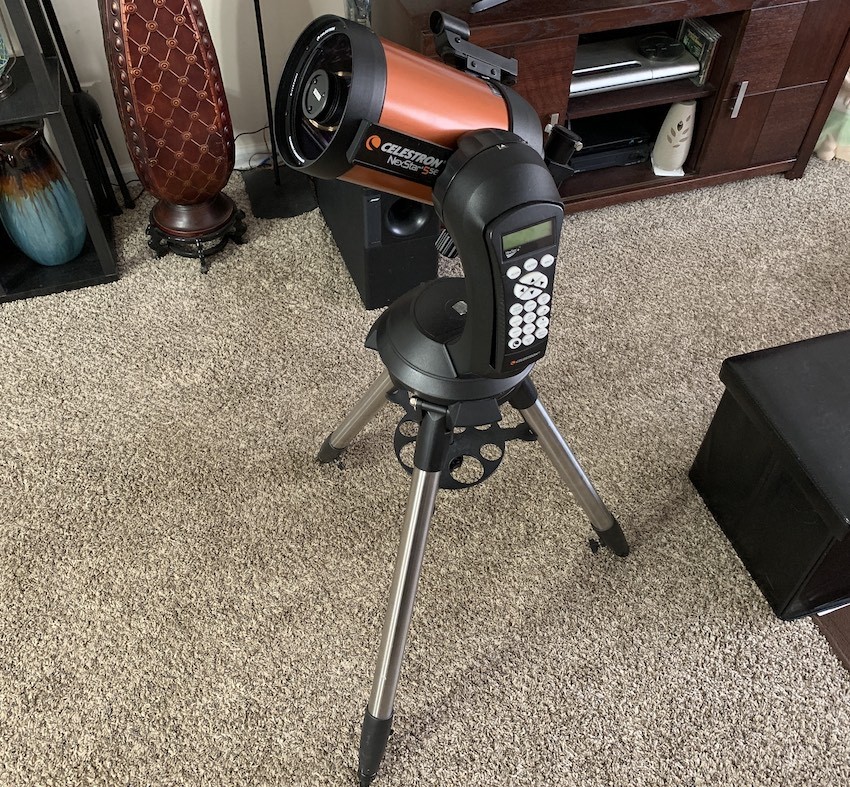
- Enough aperture and wider field for deep-sky viewing
- Fairly compact/portable
- Sturdy tripod
The Celestron NexStar 5SE (“Special Edition”) is a Schmidt-Cassegrain, so it has a shorter f/ratio than most Maksutovs (f/10) and thus will need a stronger Barlow for good planetary imaging, and slightly shorter focal length eyepieces to achieve the same given magnification as a 5” Maksutov would.
Being a Schmidt-Cassegrain, the 5SE also requires somewhat frequent collimation, which requires doing it on a star in the field and can be quite challenging even for experienced users. However, good collimation is crucial for sharp views and photos – we have heard many stories of people dismissing their Schmidt-Cassegrain as “bad” optically, only to find it to be out of collimation.
The 5SE comes with Celestron’s StarBright XLT multi-coatings for maximum light throughput.
The 5SE’s mount is quite sturdy and has gearing of reasonably high quality. However, its built-in wedge, which would eliminate field rotation in planetary images and allow for some deep-sky astrophotography, is almost entirely useless, lacking fine adjustments in latitude and with zero adjustment capability in azimuth at all.
The 5SE’s relatively large secondary mirror – covering 37.8% of the scope’s diameter – also reduces contrast by spreading out the airy disk, making fine details harder to spot visually. For imaging, this is not much of an issue.
The NexStar 5SE also comes with only a single eyepiece – a high-quality 25mm Plossl providing 50x, not particularly useful for planetary viewing. However, this can be forgiven as most telescopes require additional aftermarket eyepieces anyway.
6. Celestron Nexstar 6SE Schmidt-Cassegrain GoTo – Choice Between $1000-$1200
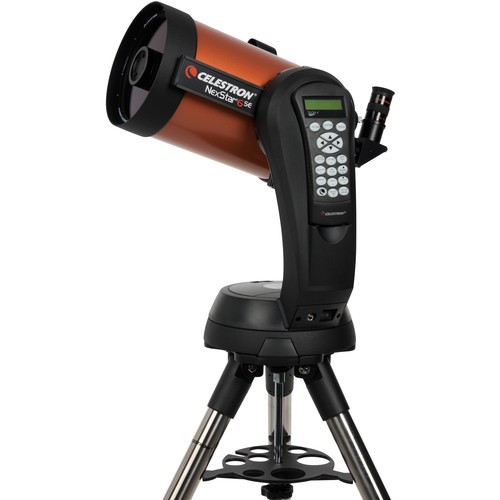
- Useful for deep-sky observation too
- Decent aperture
The 6SE optical tubes tend to be slightly higher in optical quality than their 5SE counterparts. The 6SE also has a beefier, sturdier mount than its sibling, with no silly built-in wedge. Lastly, the 6SE has a smaller central obstruction percentage-wise of the secondary mirror, leading to sharper and higher-contrast images.
Like the 5SE, the Celestron NexStar 6SE does require collimation every once in a while – and it should, of course, be checked every time you take it out.
The extra inch of aperture (for only slightly more money) of the 6SE is really not something that should be overlooked. While it does result in a larger, heavier instrument, you gain an extra 20% in resolution (and also 44% in light-gathering power) compared to the 5SE, which is quite noticeable visually and in images. This also makes the 6SE a good general-purpose telescope, as the GoTo is enough to actually start being useful and the aperture is large enough to show a fair amount of deep-sky objects. Like the 5SE, the NexStar 6SE comes with Celestron’s premium StarBright XLT multi-coatings, further amplifying the light-gathering power.
Overall, if you’re pretty interested in planetary imaging but still want a lightweight, portable telescope and want to do at least some deep-sky observation, the Celestron NexStar 6SE would be our pick.
7. Celestron Nexstar 8SE Schmidt-Cassegrain GoTo – Choice Between $1400-$1800
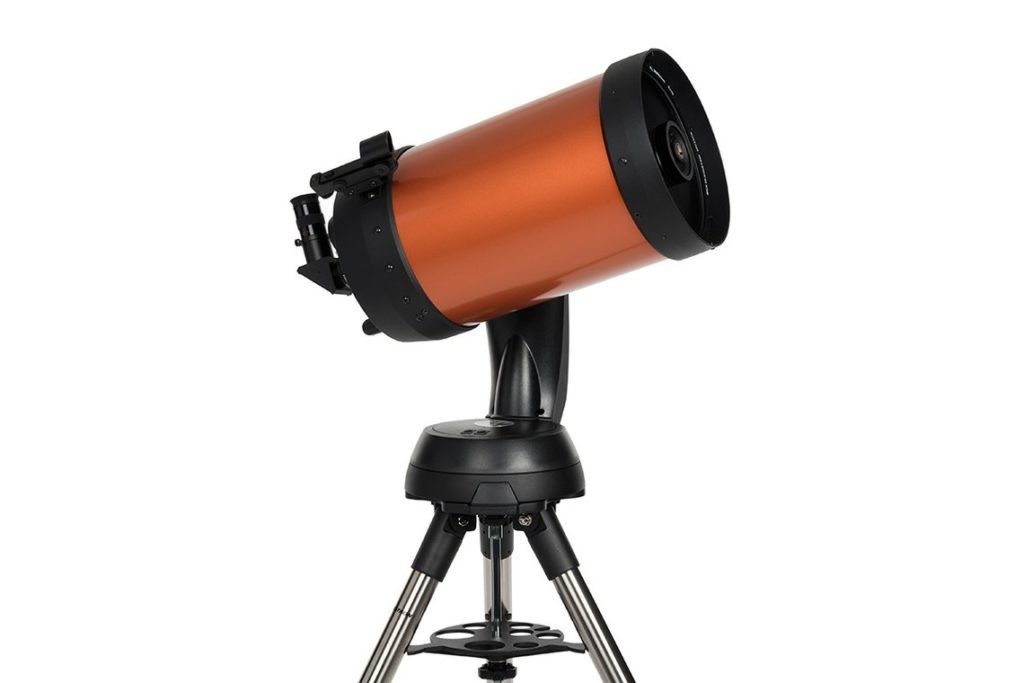
- Large aperture is great for observing all types of objects, not just planets
- Long focal length is great for planetary imaging
- Portable and quick to set up
Having an aperture of 8” allows for professional-quality planetary images and quite good views. An 8” scope will also do wonders for deep-sky objects, should you decide to express interest in that part of the hobby. Celestron’s C8 XLT optical tube is a legendary instrument packed with performance that makes it versatile for viewing and imaging all types of objects. The NexStar 8SE’s mount works the same as most of Celestron’s other computerized mounts, with a simple 2- or 3-star alignment procedure that takes minutes. Setup just requires placing the scope/mount combination atop the tripod. You get a red dot finder, a 1.25” visual back and star diagonal, and a single 25mm (81x), 1.25”, E-Lux Plossl eyepiece with the 8SE.
The main flaw of the NexStar 8SE is that it is starting to hit the limit of what the mount can hold and can be a little shaky with the tripod legs extended all the way. However, in most cases, this is acceptable.
All in all, the Celestron NexStar 8SE is a good general-purpose scope, just like its smaller brethren. However, we would definitely recommend you go for the 8” NexStar Evolution model if you can afford to do so; its sturdier mount and additional features are really worth the money.
8. Celestron 8″ NexStar Evolution Schmidt Cassegrain GoTo – Choice Above $1800-$2200
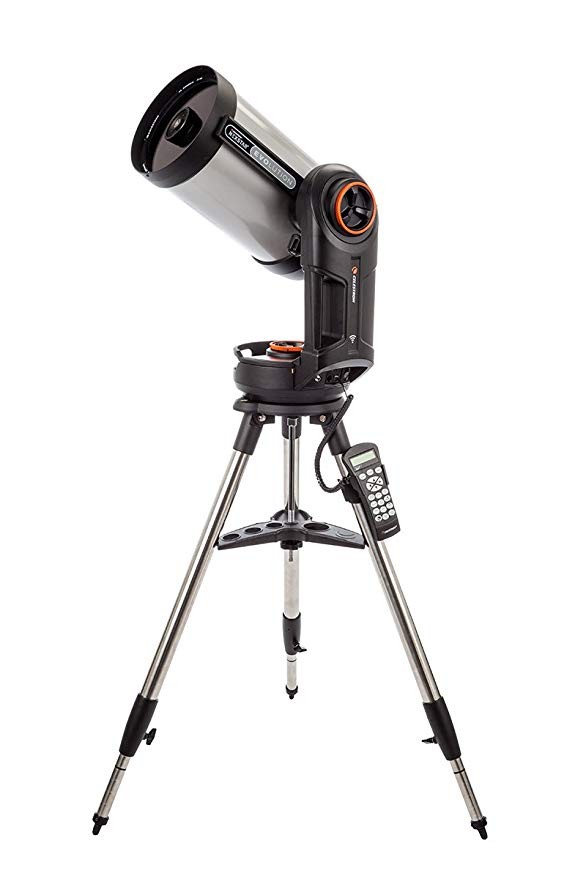
- Large aperture
- Lightweight and built in battery
- Decent supplied eyepieces
The Evolution 8 has the same C8 optical tube and NexStar hand controller as its less-expensive counterpart, the NexStar 8SE, but it’s got two major tech upgrades.
For one, it has a built-in lithium-ion battery. Every other telescope on this list is going to require a 12-volt DC power supply of some kind, except for the Evolution 8. Not having to carry around a big bulky battery, nor worry about the cord wrapping around your telescope or tripping over it is a godsend. We cannot express how awesome this feature is.
Second, you can easily control the entire telescope with your smartphone or tablet. Celestron has elected to offer a hand controller with the Evolution 8 anyway, so you can use either option – however, for the first-time user, controlling the telescope with the SkyPortal app or SkySafari is a lot easier to figure out and a lot faster to use than the standard hand controller is.
Like all SCTs, the Evolution 8 will need collimation, but this is an acceptable inconvenience. The Evolution 8 is also reasonably lightweight, weighing 38.5 pounds assembled.
Lastly, the Evolution 8 comes with two eyepieces – a 40mm (51x) and a 13mm (156x) – both Plossls of quite high quality. Coupled with a good 2x Barlow lens (which is, in any case, also needed for planetary astrophotography) or a dedicated short focal length eyepiece, these may be all you need.
The Celestron NexStar Evolution 8 is a great telescope for pretty much everything, including planetary observing/imaging.
9. Celestron Advanced VX 9.25″ Schmidt-Cassegrain GoTo – Choice Between $2200-$3000
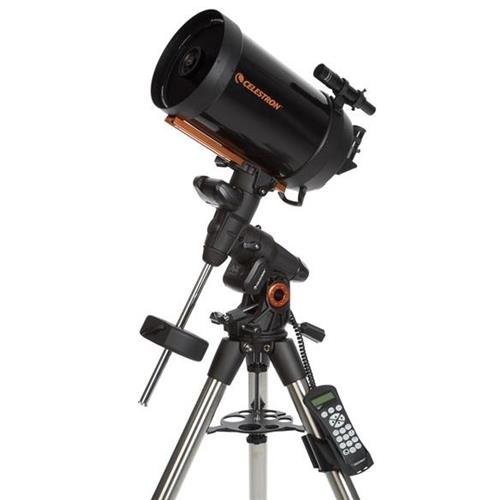
- Larger 9.25” aperture and superior optical quality than 8” SCT models provides a performance boost
- Easier to collimate than most other SCTs
- Advanced VX mount offers deep-sky imaging capabilities with other telescopes
The Celestron Advanced VX 9.25” offers a plethora of observing and imaging capabilities. The C9.25 optical tube offers slightly brighter images than an 8” telescope already, and its higher resolution capabilities are further boosted by some quirks in the optical design of the C9.25, which make it a bit sharper as well as easier to collimate. The Advanced VX mount is a highly versatile mount, and you can take the C9.25 off and use it with a smaller telescope, autoguider, and cooled or DSLR camera for deep-sky astrophotography if desired.
The Advanced VX mount does not suffer from field rotation over long planetary imaging sequences and is a lot easier to make fine adjustments with via your PC thanks to its compatibility with ASCOM drivers. Setting it up is slightly more complicated than an alt-azimuth mount since you have to polar align first, but after that process, it works just like any other GoTo mount.
The Advanced VX 9.25” package includes a 6×30 finderscope for aiming, a 1.25” screw-on visual back, a 1.25” prism star diagonal, and a 25mm Celestron E-Lux 1.25” Plossl eyepiece, providing 94x magnification with the C9.25. You’ll almost certainly want additional eyepieces and a Barlow lens for this telescope.
9. Celestron Advanced VX 11″ Schmidt-Cassegrain GoTo – Choice Between $3000-$3500
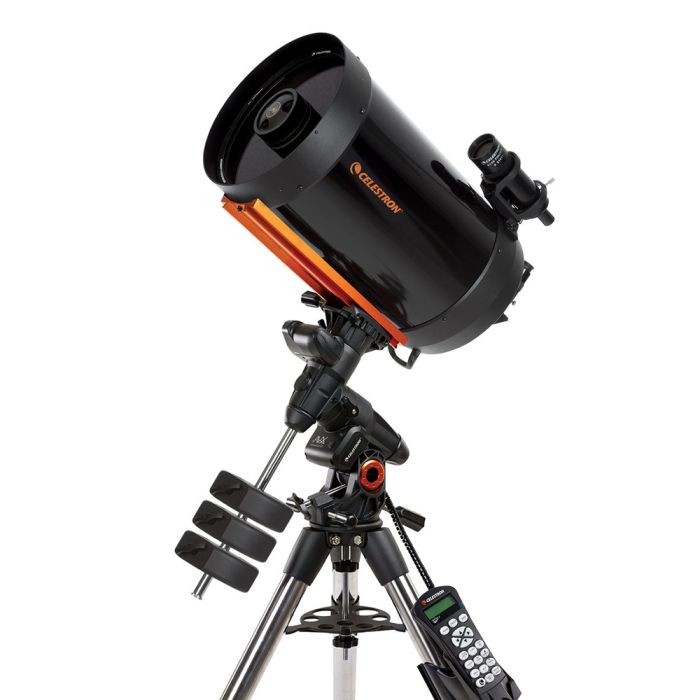
- Huge aperture allows for breathtaking views and images
- Fairly portable and quick to set up
- Advanced VX mount can be used with other telescopes for deep-sky astrophotography
As with the C9.25 package, the Advanced VX 11’s greatest strengths are its large aperture and the versatility of the Advanced VX mount. The C11 optical tube is really pushing the limits of the Advanced VX and requires good balancing to preserve the fragile internal gears, but for visual observing and planetary imaging, this combination works just fine. The C11 has light-gathering and resolving power far surpassing the smaller C8 and C9.25, making it great for all types of observing and, of course, planetary imaging. The scope comes with a 1.25” visual back, a prism star diagonal, and a 1.25”, 40mm E-Lux Plossl eyepiece providing 70x magnification, along with a 9×50 finderscope for aiming.
Tips on Choosing the Best Planetary Telescope
- Photography or visual?
If you don’t have any interest in photography, a simple Dobsonian will suffice for visual-only planetary viewing and provides far more convenience and bang for your buck. However, for purely imaging or combined photographic/visual capability, a catadioptric or Dobsonian with GoTo is probably what you want.
Also, while a refractor is great for visual planetary observation, particularly with a long focal ratio to minimize chromatic aberration or false color, with the exception of very expensive apochromats, they are largely useless for planetary photography. Chromatic aberration in photos is far more pronounced and will probably ruin them. Thus, a Newtonian or catadioptric is best for planetary imaging, and either also provides much more aperture for your dollar than a refractor.
- Focal Ratio
For planetary imaging, the focal ratio is extremely important. You typically want to have a focal ratio between f/20 and f/30. Why, you might ask? It’s because you want a good image scale—that is, for your target to take up as many pixels as possible on your camera chip (up to a certain point) for maximum resolution.
A Newtonian/Dobsonian with an f/5 or f/6 focal ratio will need a 5x Barlow or stacked weaker Barlows to achieve the necessary image scale for planetary imaging. However, there aren’t many choices for 5x Barlows on the market, they’re almost entirely useless for visual purposes, and a good one is quite expensive. Stacking Barlow lenses on top of each other will work, but it degrades the image quality somewhat and may cause focus/balancing issues.
A catadioptric, on the other hand, with a focal ratio between f/10 and f/15, only needs a 2x or 3x Barlow to achieve the necessary image scale for planetary imaging. These Barlows are far more frequently available, and can also be used for visual astronomy as well.
For visual use, focal ratio doesn’t matter much, except that a catadioptric will perform better with cheaper eyepieces than a fast Newtonian due to the long focal ratio having a steeper light cone, which is less demanding on the eyepieces optically.


Would you suggest a 12 inch GSO dobsonian as a good scope for catching fine planetary details?
The 12″ GSO (identical to the Zhumell Z12 we’ve reviewed here https://telescopicwatch.com/zhumell-z12-dobsonian-review/) is a good scope. Just keep in mind that it is huge, heavy, and you may have difficulty setting it up on your own.
Question on the f/20 – f/30 recommendation for planetary viewing. What would you say about FOV and exit pupil at that high f/ratio ? Would the fov be wide enough to keep the planet in view on a manual mount without touching it every 5 seconds ? And will the exit pupil be large enough to have reasonably bright image ?
That recommendation is for photography, not visual